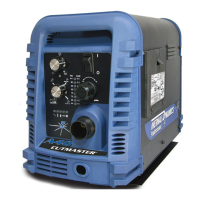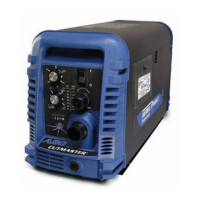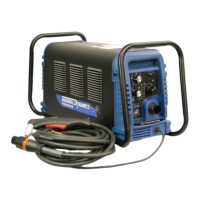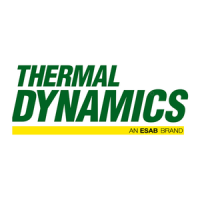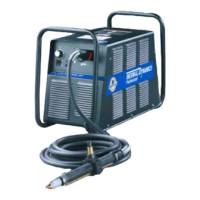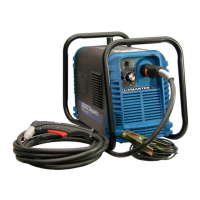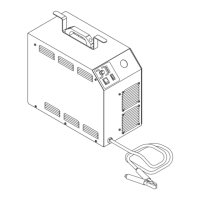CUTMASTER A120
OPERATION 4T-8 Manual 0-4989
4T.07 Gouging
!
WARNING
Be sure the operator is equipped with proper
gloves, clothing, eye and ear protection and
that all safety precautions at the front of this
manual have been followed. Make sure no
part of the operator’s body comes in con-
tact with the workpiece when the torch is
activated.
Disconnect primary power to the system be-
fore disassembling the torch, leads, or power
supply.
CAUTION
Sparks from plasma gouging can cause
damage to coated, painted or other surfaces
such as glass, plastic, and metal.
Check torch parts. The torch parts must cor-
respond with the type of operation. Refer to
Section 4T.09, Torch Parts Selection.
Gouging Parameters
Gouging performance depends on parameters
such as torch travel speed, current level, lead
angle (the angle between the torch and work-
piece), and the distance between the torch tip
and workpiece (standoff).
CAUTION
Touching the torch tip or shield cup to the
work surface will cause excessive parts
wear.
Torch Travel Speed
NOTE
Refer to Appendix Pages for additional infor-
mation as related to the Power Supply used.
Optimum torch travel speed is dependent on
current setting, lead angle, and mode of opera-
tion (hand or machine torch).
Current Setting
Current settings depend on torch travel speed,
mode of operation (hand or machine torch), and
the amount of material to be removed.
Lead Angle
The angle between the torch and workpiece
depends on the output current setting and torch
travel speed. The recommended lead angle is
35°. At a lead angle greater than 45° the molten
metal will not be blown out of the gouge and
may be blown back onto the torch. If the lead
angle is too small (less than 35°), less material
may be removed, requiring more passes. In
some applications, such as removing welds or
working with light metal, this may be desirable.
35°
Workpiece
Torch Head
Standoff Height
A-00941_AB
Gouging Angle and Standoff Distance
Standoff Distance
The tip to work distance affects gouge qual-
ity and depth. Standoff distance of 1/8 - 1/4
inch (3 - 6 mm) allows for smooth, consistent
metal removal. Smaller standoff distances may
result in a severance cut rather than a gouge.
Standoff distances greater than 1/4 inch (6 mm)
may result in minimal metal removal or loss of
transferred main arc.
Slag Buildup
Slag generated by gouging on materials such as
carbon and stainless steels, nickels, and alloyed
steels, can be removed easily in most cases.
Slag does not obstruct the gouging process if it
accumulates to the side of the gouge path. How-
ever, slag build - up can cause inconsistencies
and irregular metal removal if large amounts of
material build up in front of the arc. The build
- up is most often a result of improper travel
speed, lead angle, or standoff height.
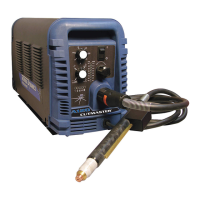
